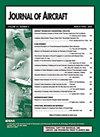Solid-State Electroaerodynamic Aircraft Design Using Signomial Programming
IF 2.1
3区 工程技术
Q2 ENGINEERING, AEROSPACE
引用次数: 0
Abstract
Electroaerodynamics (EAD) is a form of airbreathing electric propulsion that uses high voltages to produce and accelerate ions, generating thrust without any moving parts. This method of solid-state propulsion is nearly silent and produces no direct combustion emissions. This paper describes a program for designing and optimizing fixed-wing solid-state aircraft propelled solely using EAD. Signomial programming (SP), an emerging method of efficient multidisciplinary design optimization, is employed. The program incorporates performance models for state-of-the-art EAD thrusters, and for custom high-voltage power electronics. It can be used to generate vehicle specifications, or to assess the effect of technological improvements on vehicle performance. The program was used to design and build a flight demonstrator aircraft, based on a goal of achieving steady level flight. In 2017–2018, the demonstrator successfully achieved steady level flight, a first for a fixed-wing electric aircraft with solid-state propulsion. The unproven nature of the EAD propulsion system necessitated a design philosophy centered around minimal technical risk, affecting configuration selection and choice of objective function. A similar design philosophy may prove useful for other design projects with unproven propulsion systems. Finally, endurance values greater than 30 min are achievable with recent improvements in EAD thruster and battery technology.基于信号规划的固态电气动飞机设计
电空气动力学(EAD)是一种吸气式电力推进形式,它利用高压产生和加速离子,在没有任何运动部件的情况下产生推力。这种固态推进的方法几乎是无声的,并且不会产生直接的燃烧排放。本文介绍了一种基于EAD的固体固定翼飞机设计与优化程序。信号规划是一种新兴的多学科设计优化方法。该项目结合了最先进的EAD推进器和定制高压电力电子设备的性能模型。它可用于生成车辆规格,或评估技术改进对车辆性能的影响。该计划用于设计和建造一架飞行演示飞机,以实现稳定的水平飞行为目标。2017-2018年,验证机成功实现了稳定水平飞行,这是固定翼固态推进电动飞机首次实现稳定水平飞行。EAD推进系统的未经验证的性质需要以最小的技术风险为中心的设计理念,影响配置选择和目标功能的选择。类似的设计理念可能对其他未经验证的推进系统的设计项目有用。最后,随着EAD推进器和电池技术的最新改进,可以实现超过30分钟的续航值。
本文章由计算机程序翻译,如有差异,请以英文原文为准。
求助全文
约1分钟内获得全文
求助全文
来源期刊

Journal of Aircraft
工程技术-工程:宇航
CiteScore
4.50
自引率
31.80%
发文量
141
审稿时长
6 months
期刊介绍:
This Journal is devoted to the advancement of the applied science and technology of airborne flight through the dissemination of original archival papers describing significant advances in aircraft, the operation of aircraft, and applications of aircraft technology to other fields. The Journal publishes qualified papers on aircraft systems, air transportation, air traffic management, and multidisciplinary design optimization of aircraft, flight mechanics, flight and ground testing, applied computational fluid dynamics, flight safety, weather and noise hazards, human factors, airport design, airline operations, application of computers to aircraft including artificial intelligence/expert systems, production methods, engineering economic analyses, affordability, reliability, maintainability, and logistics support, integration of propulsion and control systems into aircraft design and operations, aircraft aerodynamics (including unsteady aerodynamics), structural design/dynamics , aeroelasticity, and aeroacoustics. It publishes papers on general aviation, military and civilian aircraft, UAV, STOL and V/STOL, subsonic, supersonic, transonic, and hypersonic aircraft. Papers are sought which comprehensively survey results of recent technical work with emphasis on aircraft technology application.
 求助内容:
求助内容: 应助结果提醒方式:
应助结果提醒方式:


